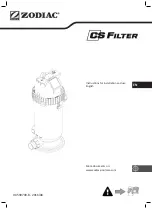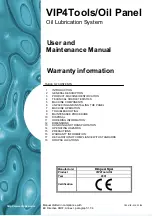
E. Maintenance
E.1 Filter Cartridges
Sediment and carbon filters have different effective lives when used on
different water systems. The amount of use that the cartridge receives also
determines its life. A family of two usually will not use as much filtered water as
a family of six. No amount of water metering or maintenance scheduling will be
an absolute guarantee of performance. Common sense, and the help of your
local water treatment professional is still the best way to maintain a properly
functioning filtration system. New cartridges (and changing cartridges often)
will enhance performance.
A sediment filter’s function is to remove suspended particles from the water,
thus reducing the possibility of clogging the reverse osmosis membrane. The
flow rate will slow down as the cartridge becomes clogged. When the water
flow slows down perceptively, it’s time to change the cartridge. Depending on
your water supply, this could be as soon as 2 months, or as long as 1 year. We
recommend at least an annual change.
Carbon cartridges remove taste and odor, chlorine, pesticides, and other
contaminants from water. Special advanced-style carbon blocks also remove
metals such as lead, iron, and copper. They also prevent iron fouling of the
quartz sleeves in UV equipped systems. The carbon cartridges should be
changed at a minimum every 12 months (or earlier if you notice any change in
the taste or smell of your water). Again, your local water professional will be
familiar with the quality of your water supply and can offer valuable advice
and/or periodic testing, depending on the quality of your feed water.
Replacing Filter Cartridges
1.1 Turn off the feed water supply to the RO system assembly. Open the
RO faucet and let it bleed all the water from the RO holding tank.
1.2 Turn the storage tank valve to the closed position. (90 degree angle to
the water line.)
1.3 Unscrew the filter housing sumps by hand or with a spanner wrench.
1.4 Remove the used cartridge and discard. Rinse out each of the
housings and fill about 1/3 full with water. Add 2 to 3 tablespoons of
bleach and scrub thoroughly with a brush or sponge. Rinse thoroughly.
1.5 Remove the o-ring from the housing and wipe the groove and o-ring
clean. Lubricate the o-ring with a coating of clean petroleum jelly.
Place the o-ring back into the groove. If the o-ring appears damaged
or crimped, it should be replaced immediately.
1.6 Install the new cartridge into the sump making sure that it slips down
over the sump standpipe.
1.7 Turn the sump into the cap and hand tighten. DO NOT OVER TIGHTEN.
If the membrane needs to be changed, go to
Replacing the RO Membrane
1.8 Slowly turn on the feed (incoming) water supply and allow the housings
to fill with water. Check for any leaks.
1.9 Turn the storage tank valve to the open position (parallel with the
water line).
8






























